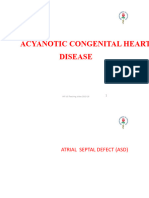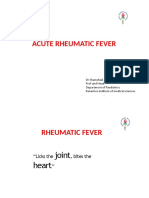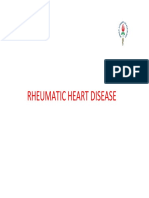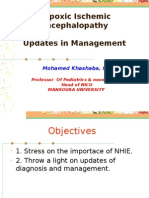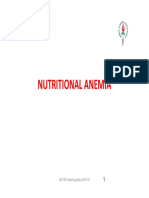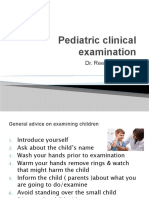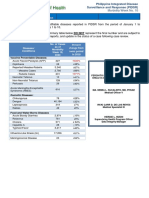0 ratings0% found this document useful (0 votes)
147 viewsImmune Thrombocytopenic Purpura: IAP UG Teaching Slides 2015-16
Immune Thrombocytopenic Purpura: IAP UG Teaching Slides 2015-16
Uploaded by
KathirImmune thrombocytopenic purpura (ITP) is an autoimmune disorder characterized by low platelet count and bleeding. It most commonly presents in children aged 1-7 years. ITP is caused by antibodies against platelets that result in platelet destruction and decreased production. Treatment involves corticosteroids, IV immunoglobulin, or anti-D immunoglobulin for acute cases, and observation or splenectomy for chronic cases.
Copyright:
© All Rights Reserved
Available Formats
Download as PPTX, PDF, TXT or read online from Scribd
Immune Thrombocytopenic Purpura: IAP UG Teaching Slides 2015-16
Immune Thrombocytopenic Purpura: IAP UG Teaching Slides 2015-16
Uploaded by
Kathir0 ratings0% found this document useful (0 votes)
147 views26 pagesImmune thrombocytopenic purpura (ITP) is an autoimmune disorder characterized by low platelet count and bleeding. It most commonly presents in children aged 1-7 years. ITP is caused by antibodies against platelets that result in platelet destruction and decreased production. Treatment involves corticosteroids, IV immunoglobulin, or anti-D immunoglobulin for acute cases, and observation or splenectomy for chronic cases.
Original Title
ITP.pptx
Copyright
© © All Rights Reserved
Available Formats
PPTX, PDF, TXT or read online from Scribd
Share this document
Did you find this document useful?
Is this content inappropriate?
Immune thrombocytopenic purpura (ITP) is an autoimmune disorder characterized by low platelet count and bleeding. It most commonly presents in children aged 1-7 years. ITP is caused by antibodies against platelets that result in platelet destruction and decreased production. Treatment involves corticosteroids, IV immunoglobulin, or anti-D immunoglobulin for acute cases, and observation or splenectomy for chronic cases.
Copyright:
© All Rights Reserved
Available Formats
Download as PPTX, PDF, TXT or read online from Scribd
Download as pptx, pdf, or txt
0 ratings0% found this document useful (0 votes)
147 views26 pagesImmune Thrombocytopenic Purpura: IAP UG Teaching Slides 2015-16
Immune Thrombocytopenic Purpura: IAP UG Teaching Slides 2015-16
Uploaded by
KathirImmune thrombocytopenic purpura (ITP) is an autoimmune disorder characterized by low platelet count and bleeding. It most commonly presents in children aged 1-7 years. ITP is caused by antibodies against platelets that result in platelet destruction and decreased production. Treatment involves corticosteroids, IV immunoglobulin, or anti-D immunoglobulin for acute cases, and observation or splenectomy for chronic cases.
Copyright:
© All Rights Reserved
Available Formats
Download as PPTX, PDF, TXT or read online from Scribd
Download as pptx, pdf, or txt
You are on page 1of 26
IMMUNE THROMBOCYTOPENIC
PURPURA
IAP UG Teaching slides 2015-16 1
INTRODUCTION
• Platelets are non nucleated cellular fragments
• Produced from megakaryocytes in the bone marrow
• Megakaryocytes are large polypoid cells
• Mature megakaryocyte - budding of cytoplasm
occurs & large number of platelets are liberated into
circulation
• Thrombopoeitin- primary growth factor controls
platelet production
IAP UG Teaching slides 2015-16 2
INTRODUCTION
• Normal platelet count
Newborn 84,000 - 4,78,000 cells/ cu mm
After 1 week - adults - 1,50,000- 4,00,000 cells/mm3
• Average life span of platelets- 7- 10 days
• Decrease in platelet count - Thrombocytopenia
• Increase in platelet count - Thrombocytosis
IAP UG Teaching slides 2015-16 3
THROMBOCYTOPENIA
• Platelet count - < 1,50,000 cells/cu mm
• Causes
• Increased platelet sequestration
Hypersplenism, Hypothermia, Burns
• Increased platelet destruction
• Immune, Non immune
3. Decreased platelet production
IAP UG Teaching slides 2015-16 4
CUT - OFF VALUES
• Neonates - 20,000 - 50,000 cells/mm3
[high risk for ICH]
• Children - 10,000- 20,000 cells/ mm3
• Spontaneous bleeding do not occur until counts are
< 20,000 cells/mm3
IAP UG Teaching slides 2015-16 5
IMMUNE THROMBOCYTOPENIC PURPURA
• Commonest bleeding disorder manifesting in
children.
• Usual age of presentation - between 1-7 years.
• Acute ITP- lasts less than 6 months.
• Chronic ITP- lasts more than 6 months.
• The majority of children [60-75%] are likely to have
acute ITP and that resolves within 2-4 months of
diagnosis, regardless of therapy.
IAP UG Teaching slides 2015-16 6
ITP - PATHOGENESIS
• Secondary to antibodies directed against the platelet
glycoprotein II b/ III a complex
• These platelets are trapped in the spleen, where
they are removed by macrophages
• Mechanism of production of antibodies is not known
• Hall mark is increased number of megakaryocytes in
the bone marrow
• Th1 dominant pro- inflammatory cytokine state is
also described recently
IAP UG Teaching slides 2015-16 7
ACUTE ITP
• Benign, self limited
• Young children [<10 years ]
• Often Viral infection or Vaccination precedes
• Resolves within weeks or a few months of original
presentation.
IAP UG Teaching slides 2015-16 8
CHRONIC ITP
• Persistence of Thrombocytopenia [ <150000/mm3 ]
for longer than 6 months after initial presentation
• > 10 years
• Insidious onset
• Female gender.
IAP UG Teaching slides 2015-16 9
ITP -CLINICAL FEATURES
• Abrupt onset of bruising & bleeding in an otherwise
healthy child
• H/O preceding viral illness or vaccination +/-
• Seasonal clustering of cases and more frequent
during change of seasons
• Petechiae, purpura & ecchymosis
• Epistaxis & oral mucosal bleeds occur in < 1/3rd
• Hematuria, hematochezia, melena in < 10%
• Menorrhagia
IAP UG Teaching slides 2015-16 10
ITP - CLINICAL FEATURES ( CONT..)
• Palpable spleen - < 10% cases
• Symptoms & signs depend on the platelet count
• Bleeding is mild unless the platelet count falls
<20,000/cu mm
• Petechiae & ecchymosis can occur following mild
trauma with a platelet count of 20000-50000/mm3
• No dysmorphic features/bony anomalies/
hyperpigmentation
• Suspect malignancy when there is malaise, bone pain,
organomegaly or lymphadenopathy
IAP UG Teaching slides 2015-16 11
CLASSIFICATION - BASED ON SYMPTOMS
1. No symptoms
2. Mild symptoms - bruising , petechiae, occasional
minor epistaxis & very little interference with daily
living
3. Moderate symptoms - more severe skin & mucosal
bleeds, more troublesome epistaxis & menorrhagia
4. Severe symptoms - bleeding episodes -
menorrhagia, epistaxis, melena- requiring
transfusion or hospitalization, symptoms interfering
seriously with the quality of life
IAP UG Teaching slides 2015-16 12
INVESTIGATIONS
• Complete blood count:-
• Low platelet count, Hb% and WBC counts are normal
• Peripheral smear evaluation
• To see all cell lines, to estimate the platelet count & to
exclude spurious thrombocytopenia, to examine for
abnormal cells [ blasts] or malarial parasites
• Circulatory platelets are larger in size, indicating increased
production
• Liver function tests & Lactate dehydrogenase levels
• To rule out Hepatitis, Malignancy & Hemolysis
IAP UG Teaching slides 2015-16 13
INVESTIGATIONS
• Evaluate all cases with fever for infection
• Screening tests for disseminated intravascular
coagulopathy when sepsis is suspected
• Bone marrow examination- Aspiration/Biopsy
indicated in
• Abnormal WBC count or differential
• Unexplained anemia
• History & physical examination suggestive of bone
marrow failure
• Failure of initial therapy
IAP UG Teaching slides 2015-16 14
ADDITIONAL TESTS [CHRONIC CASES]
• Screening tests for Immunodeficiency
• Anti nuclear antibodies
• Direct Coomb’s test
• Anti phospholipid antibody assay
• Thyroid function tests
• Blood counts and peripheral smear for parents
• Serology testing for platelet antibody is seldom
useful.
IAP UG Teaching slides 2015-16 15
MANAGEMENT
• Child’s activity should be limited
• Aspirin containing medication should be avoided
• Detailed education & counseling of the family and
patient
• Careful follow up
• Observation only
Platelet count >20,000/mm3 & only minor purpura
• Platelet transfusion in ITP is contra indicated unless
life-threatening bleeding is present
IAP UG Teaching slides 2015-16 16
FIRST LINE MEDICAL THERAPIES
• Corticosteroids
• Intra venous Immunoglobulin
• Anti D
IAP UG Teaching slides 2015-16 17
CORTICOSTEROIDS
• Inhibition of both phagocytosis & Antibody
production
• Improved platelet production and micro vascular
endothelial stability
• Dose
Prednisolone - 1-4 mg/kg/day x 2-3 weeks &
tapered Dexamethasone - 20mg/mt2 over 4 days
every 3 weeks for 4-6 courses
Alternate- mega pulse dose therapy
Methyl Prednisolone 30mg/kg/day IV / oral x 3days
IAP UG Teaching slides 2015-16 18
INTRA VENOUS IMMUNOGLOBULIN
• Clearance of antibody coated blood cells from the
circulation by inhibiting the phagocytic activity of
cells of reticulo-endothelial system
• Fc receptor blockade
• Dose - 2gm/kg divided over 2-5 days
• Expensive but cost effective
• Side effects:- flu like symptoms, aseptic meningitis,
anaphylaxis, hemolytic anemia, HCV transmission
• Duration of response is brief [2-4 weeks]
IAP UG Teaching slides 2015-16 19
ANTI - D
• Plasma derived Immunoglobulin prepared from
donors selected for a high titer of anti Rh antibody
• Elicits an increase in platelet counts along with mild
to moderate anemia
• Can only be used in Rh positive patients
• Dose - 50-75 micro gm./kg as IV infusion
• Therapeutic effect lasts for 1-5 weeks
• Side effects:- headache, nausea, chills, dizziness,
fever, hemolysis
IAP UG Teaching slides 2015-16 20
MANAGEMENT OF CHRONIC ITP
• Primary goal - prevent bleeding episodes & not to
cure the disease
• 1/3 of these children will go into remission in months
or years later
• Observation alone is an approach for many patients,
especially those with minimal symptoms
IAP UG Teaching slides 2015-16 21
SPLENECTOMY
Indications for Splenectomy
•Children with ITP for more than 1 year
•Symptoms of bleeding and counts
• < 10000/mm3 [ 3-12 yrs. of age]
• 10000- 30000/mm3 [8- 12 yrs. of age]
IAP UG Teaching slides 2015-16 22
MANAGEMENT OF C/C ITP
• First line Medical therapy:-
Intermittent Steroids, IV Ig, Anti D
• Second line therapy - for 10- 15% of children who
fail to respond to first line drugs / splenectomy
• Danazole - 300- 400 mg/m2/day orally for 2 months
• Vinca Alkaloids - Vincristine 1.5 mg/m2 IV weekly x 1
month
• Azathioprine - 50-200 mg/m2/day orally for 4- 6
months
• Cyclosporine - 5mg/kg/day in divided dose
• Cyclophosphamide & Interferon may be used
• Plasmapheresis may be done
IAP UG Teaching slides 2015-16 23
LIFE THREATENING HEAMORRHAGE
• Intra venous Immunoglobulin- 1gm/kg
• Anti D - 50- 75 microgram/kg as IV Infusion
• High dose Corticosteroid - IV Methyl Prednisolone
30mg/kg
• Platelet Transfusion
• A combination of above can be tried
IAP UG Teaching slides 2015-16 24
PROGNOSIS
• Excellent chance of recovery, irrespective of therapy
• Platelet count returns to normal in 4-8 weeks in ½ of
the patients and in 2/3 of children by 3 months after
diagnosis
• 5% have recurrent ITP, characterized by intermittent
episodes of thrombocytopenia followed by lengthy
periods of remission
IAP UG Teaching slides 2015-16 25
THANK YOU
IAP UG Teaching slides 2015-16 26
You might also like
- Study Group الملزمة الاولىDocument233 pagesStudy Group الملزمة الاولىMoustafa Magdy100% (1)
- Neonatal JaundiceDocument32 pagesNeonatal JaundiceKiran KumarNo ratings yet
- Examination of Cardiovascular System: IAP UG Teaching Slides 2015-16Document76 pagesExamination of Cardiovascular System: IAP UG Teaching Slides 2015-16Abdullah Mohammad Ibne Haider100% (1)
- Lesson Plan ON GlomerulonephritisDocument12 pagesLesson Plan ON GlomerulonephritisVeenasravanthiNo ratings yet
- Acute-Bacterial-Meningitis - in ChildrenDocument49 pagesAcute-Bacterial-Meningitis - in ChildrenMitulNo ratings yet
- Hypertension: IAP UG Teaching Slides 2015-16Document36 pagesHypertension: IAP UG Teaching Slides 2015-16Umesh SinghNo ratings yet
- Downs SyndromeDocument30 pagesDowns SyndromeJewel SNo ratings yet
- Congestive - Cardiac-FailureDocument38 pagesCongestive - Cardiac-FailureAkhil R KrishnanNo ratings yet
- Hypo Thyroid Is MDocument33 pagesHypo Thyroid Is Msathvik gowdaNo ratings yet
- Acyanotic CHDDocument56 pagesAcyanotic CHDSiva SakthiNo ratings yet
- Hepato Splenomegaly: IAP UG Teaching Slides 2015-16Document20 pagesHepato Splenomegaly: IAP UG Teaching Slides 2015-16AnchalNo ratings yet
- Acute Respiratory InfectionsDocument22 pagesAcute Respiratory InfectionsKumara GuruNo ratings yet
- Examination of AbdomenDocument67 pagesExamination of Abdomenvikram kumarNo ratings yet
- HepatosplenomegalyDocument49 pagesHepatosplenomegalyTarun SinghNo ratings yet
- Growth Assessment IAPDocument43 pagesGrowth Assessment IAPAby DanyNo ratings yet
- Tubercular-Meningitis - in ChildrenDocument64 pagesTubercular-Meningitis - in ChildrenMitul100% (2)
- Respiratory DistressDocument34 pagesRespiratory DistressSindhiya DurairajanNo ratings yet
- Bleeding (Platelet) Disorder: IAP UG Teaching Slides 2015 16Document45 pagesBleeding (Platelet) Disorder: IAP UG Teaching Slides 2015 16Kumara GuruNo ratings yet
- Breast Feeding: IAP UG Teaching Slides 2015-16Document70 pagesBreast Feeding: IAP UG Teaching Slides 2015-16Kumara Guru100% (1)
- Pem PDFDocument73 pagesPem PDFDr Divyarani D CNo ratings yet
- Neonatal Case SheetDocument18 pagesNeonatal Case SheetJohnsatish Rudrapogu100% (1)
- Acute Glomerulonephritis PDFDocument27 pagesAcute Glomerulonephritis PDFRaj RNo ratings yet
- Normal Growth PDFDocument50 pagesNormal Growth PDFAby DanyNo ratings yet
- Pneumonia in Children: IAP UG Teaching Slides 2015 16Document28 pagesPneumonia in Children: IAP UG Teaching Slides 2015 16Ananya Anaparthi100% (1)
- Juvenile Idiopathic ArthritisDocument15 pagesJuvenile Idiopathic ArthritisshushmaNo ratings yet
- Juvenile Idiopathic Arthritis (Jia) : IAP UG Teaching Slides 2015-16Document15 pagesJuvenile Idiopathic Arthritis (Jia) : IAP UG Teaching Slides 2015-16KathirNo ratings yet
- Perinatal Asphyxia: Walter Otieno Consultant PaediatricianDocument25 pagesPerinatal Asphyxia: Walter Otieno Consultant PaediatricianMalueth AnguiNo ratings yet
- Nutrition & Nutritional AssessmentDocument57 pagesNutrition & Nutritional Assessmentmridul mithNo ratings yet
- Approach To A Bleeding NeonateDocument51 pagesApproach To A Bleeding NeonateJosmy JosephNo ratings yet
- Hypoxic Ischemic EncephalopathyDocument78 pagesHypoxic Ischemic EncephalopathyUmesh SinghNo ratings yet
- NNF Ready ReckonerDocument6 pagesNNF Ready ReckonerKicku100% (1)
- Pediatric InstrumentsDocument30 pagesPediatric InstrumentsSanjit PandeyNo ratings yet
- Nelson's Hour - 58-60Document51 pagesNelson's Hour - 58-60Josselle Sempio CalientaNo ratings yet
- ToxicologyDocument46 pagesToxicologyShashi KarirNo ratings yet
- Acute Rheumatic FeverDocument57 pagesAcute Rheumatic FeverFaizan KhanNo ratings yet
- Bleeding (Platelet) Disorder: IAP UG Teaching Slides 2015-16Document45 pagesBleeding (Platelet) Disorder: IAP UG Teaching Slides 2015-16KathirNo ratings yet
- Rheumatic Heart DiseaseDocument43 pagesRheumatic Heart DiseaseVickeeNo ratings yet
- Division of Perinatology Department of Child Health Medical School University of Sumatera UtaraDocument37 pagesDivision of Perinatology Department of Child Health Medical School University of Sumatera UtaraJosephine IrenaNo ratings yet
- Pediatric SMLE NotesDocument25 pagesPediatric SMLE NotesMarwa Tariq Ahmed Abdulla Ahmed Al MurbatiNo ratings yet
- Iap National Level Paediatric - Quiz 2016 For Undergraduates and Postgraduates Intra Collegiate RoundDocument1 pageIap National Level Paediatric - Quiz 2016 For Undergraduates and Postgraduates Intra Collegiate RoundArun V0% (1)
- Hypoxic Ischemic Encephalopathy Updates in ManagementDocument67 pagesHypoxic Ischemic Encephalopathy Updates in Managementlordoftheweb100% (7)
- Nutritional-Anemia IAPDocument41 pagesNutritional-Anemia IAPVinod GornaleNo ratings yet
- Pediatric Clinical ExaminationDocument37 pagesPediatric Clinical ExaminationHalema Al OkshNo ratings yet
- Dokumen - Tips Xvimsupdates 6aprilnew Iap Ug Teacing Module 2016-04-11 SupraventricularDocument41 pagesDokumen - Tips Xvimsupdates 6aprilnew Iap Ug Teacing Module 2016-04-11 Supraventricularkuruva gayathriNo ratings yet
- Lecture 11 Failure To Thrive (FTT)Document25 pagesLecture 11 Failure To Thrive (FTT)jaish8904100% (2)
- Management of Paediatric Diabetic KetoacidosisDocument21 pagesManagement of Paediatric Diabetic KetoacidosisAsad M AminNo ratings yet
- Sickle Cell Anemia PowerpointDocument29 pagesSickle Cell Anemia Powerpointapi-263353704100% (1)
- Physical Growth and Development: Different Aspects and AssessmentDocument60 pagesPhysical Growth and Development: Different Aspects and AssessmentDipti RamiNo ratings yet
- Neonatal Jaundice (Wong)Document54 pagesNeonatal Jaundice (Wong)Siti Hajar100% (1)
- Neonatal SepsisDocument20 pagesNeonatal SepsisJustine Nyangaresi100% (1)
- Approach To Hematuria and Proteinuria in ChildrenDocument52 pagesApproach To Hematuria and Proteinuria in ChildrenMysheb SS100% (1)
- Infant Growth and DevelopmentDocument111 pagesInfant Growth and DevelopmentAdnan QamarNo ratings yet
- Genetics: IAP UG Teaching Slides 2015-16Document39 pagesGenetics: IAP UG Teaching Slides 2015-16AkkiNo ratings yet
- HTTPSWWW Vims Ac Ineducationpdffat-Soluble-Vitamins PDFDocument45 pagesHTTPSWWW Vims Ac Ineducationpdffat-Soluble-Vitamins PDFSrikar Chowdary BurugupalliNo ratings yet
- Nutritional Needs of ChildrenDocument68 pagesNutritional Needs of ChildrenRani G SNo ratings yet
- NICU Feeding GuidelineDocument4 pagesNICU Feeding Guidelinefadhlialbani100% (1)
- Acute Flaccid ParalysisDocument47 pagesAcute Flaccid ParalysisVandanaNo ratings yet
- Bronchial Asthma PDFDocument32 pagesBronchial Asthma PDFArpitha YadavalliNo ratings yet
- Pediatric Genetics NotesDocument96 pagesPediatric Genetics Noteskkkssbb100% (1)
- The Critically Ill Child Pediatrics 2018 - PDFDocument17 pagesThe Critically Ill Child Pediatrics 2018 - PDFgtsantosNo ratings yet
- The Ideal Neutropenic Diet Cookbook; The Super Diet Guide To Replenish Overall Health For A Vibrant Lifestyle With Nourishing RecipesFrom EverandThe Ideal Neutropenic Diet Cookbook; The Super Diet Guide To Replenish Overall Health For A Vibrant Lifestyle With Nourishing RecipesNo ratings yet
- Role of Dietary Fibers and Nutraceuticals in Preventing DiseasesFrom EverandRole of Dietary Fibers and Nutraceuticals in Preventing DiseasesRating: 5 out of 5 stars5/5 (1)
- Offer Letter For PracticalDocument1 pageOffer Letter For PracticalKathirNo ratings yet
- Leukemia: IAP UG Teaching Slides 2015-16Document45 pagesLeukemia: IAP UG Teaching Slides 2015-16Kathir100% (1)
- Covid-19 Test Report: Patient InformationDocument1 pageCovid-19 Test Report: Patient InformationKathirNo ratings yet
- OT ListDocument1 pageOT ListKathirNo ratings yet
- Referral Slip2Document1 pageReferral Slip2KathirNo ratings yet
- Breechpresentation Copy 141124075623 Conversion Gate02 PDFDocument38 pagesBreechpresentation Copy 141124075623 Conversion Gate02 PDFKathirNo ratings yet
- Juvenile Idiopathic Arthritis (Jia) : IAP UG Teaching Slides 2015-16Document15 pagesJuvenile Idiopathic Arthritis (Jia) : IAP UG Teaching Slides 2015-16KathirNo ratings yet
- Bleeding (Platelet) Disorder: IAP UG Teaching Slides 2015-16Document45 pagesBleeding (Platelet) Disorder: IAP UG Teaching Slides 2015-16KathirNo ratings yet
- Hemolytic Anemia: IAP UG Teaching Slides 2015-16Document38 pagesHemolytic Anemia: IAP UG Teaching Slides 2015-16Kathir100% (1)
- Management of DiarrheaDocument13 pagesManagement of DiarrheaKathirNo ratings yet
- Iodine Metabolism, Thyroid Hormone Function and DisorderDocument58 pagesIodine Metabolism, Thyroid Hormone Function and DisorderRendy LectusNo ratings yet
- Hydrocephalus AND Neural Tube DefectDocument7 pagesHydrocephalus AND Neural Tube DefectTherese ArellanoNo ratings yet
- Pre Final Exam NCM 118Document26 pagesPre Final Exam NCM 118Faith Bugtong100% (1)
- (PCOL) Cardio and Renal Drugs - Test BankDocument20 pages(PCOL) Cardio and Renal Drugs - Test BankGriselle GomezNo ratings yet
- Ora2020 Article DyspneaPerceptionAndNeurologic-1Document4 pagesOra2020 Article DyspneaPerceptionAndNeurologic-1Ruby FirdausNo ratings yet
- Communcable and Non-Communicable DiseasesDocument15 pagesCommuncable and Non-Communicable DiseasesRon ChongNo ratings yet
- Hematology KBMD 10.02.24Document25 pagesHematology KBMD 10.02.24Dr Nikita NNo ratings yet
- Ha RleDocument14 pagesHa RleCamille ParedesNo ratings yet
- 2020 PIDSR WeeklDocument1 page2020 PIDSR WeeklErrol LlanesNo ratings yet
- Kuay Lol Fuck You ScribdDocument73 pagesKuay Lol Fuck You ScribdBook BookNo ratings yet
- Atypical Manifestations of Acute Coronary Syndrome - Throat Discomfort: A Multi-Center Observational StudyDocument8 pagesAtypical Manifestations of Acute Coronary Syndrome - Throat Discomfort: A Multi-Center Observational StudyYo MeNo ratings yet
- FAMILY CASE STUDY Raw 1Document38 pagesFAMILY CASE STUDY Raw 1Francis PeterosNo ratings yet
- Module 3 Ab PsychDocument6 pagesModule 3 Ab PsychGwen MendozaNo ratings yet
- English7 Q2 M5 v2 (Final) PDFDocument28 pagesEnglish7 Q2 M5 v2 (Final) PDFElnz Gorme64% (11)
- CMQCC - Maternal Early Warning SystemDocument3 pagesCMQCC - Maternal Early Warning SystemDesi WildayaniNo ratings yet
- Dpban1906190107341 Ad Insur PRSPL PG1 Nitesh Soni 19810325Document1 pageDpban1906190107341 Ad Insur PRSPL PG1 Nitesh Soni 19810325Digi CreditNo ratings yet
- Sindrome de Respuesta InflamatoriaDocument12 pagesSindrome de Respuesta InflamatoriaYul CruzNo ratings yet
- Dsip 2.4 BMX Mouthwash, Nitrofurantoin, OndansetronDocument17 pagesDsip 2.4 BMX Mouthwash, Nitrofurantoin, OndansetronGreatness AgwazeNo ratings yet
- Health Appraisal Record I. PERSONAL DATA: Marbella, Marat B. Gender:MALE Age:16 II. Physical and Medical ExaminationDocument2 pagesHealth Appraisal Record I. PERSONAL DATA: Marbella, Marat B. Gender:MALE Age:16 II. Physical and Medical ExaminationMarat Marbella100% (1)
- RCSD or RCCD Peripheral WITHDocument2 pagesRCSD or RCCD Peripheral WITHEmma LiamNo ratings yet
- Mark Welford - Geographies of Plague Pandemics - The Spatial-Temporal Behavior of Plague To The Modern Day-Routledge (2018)Document165 pagesMark Welford - Geographies of Plague Pandemics - The Spatial-Temporal Behavior of Plague To The Modern Day-Routledge (2018)RAMO STEF SZEKERESNo ratings yet
- HEMORRHOIDSDocument4 pagesHEMORRHOIDSarshi khanNo ratings yet
- Invictus PPT NotesDocument22 pagesInvictus PPT NoteszheenNo ratings yet
- Introduction To Poisoning A Systematic ReviewDocument11 pagesIntroduction To Poisoning A Systematic ReviewREiNo ratings yet
- Brain AbscessDocument1 pageBrain AbscessByron MacalintalNo ratings yet
- Achalasia: History & ExamDocument28 pagesAchalasia: History & ExamMicija CucuNo ratings yet
- ReviewerDocument24 pagesReviewerMaria Lourdes ReyesNo ratings yet
- 330 84 PBDocument91 pages330 84 PBDekaria AlamandaNo ratings yet









